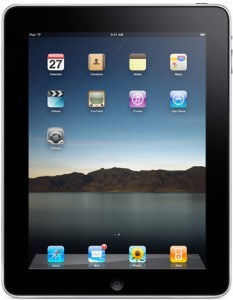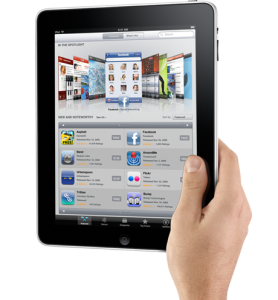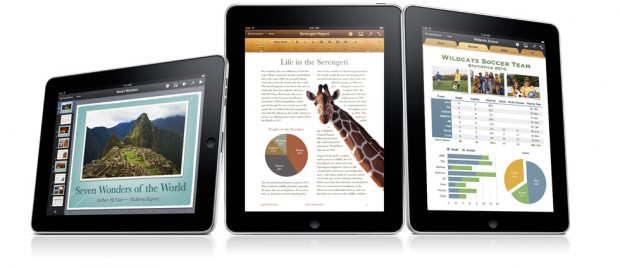Apple's iPad: Will it Find a Place in Your World?
/ On January 27th, in the year twenty-ten, Steve Jobs announced to the world Apple's latest creation, the iPad, coming to stores in March and starting at $499. The world responded with mixed reviews. Journalists and others within range of Jobs' "Reality distortion field" — some of whom managed to get hands-on time with the iPad — were definitely keener on the device than those who learned about it online and through other media outlets. Leo Laporte, founder of This Week in Tech went so far as to say, "I think this is going to save newspapers." Elsewhere on the web, some expressed disappointment, while other posts like "Five Reasons the iPad Will Fail” sprang up left and right. Why the difference of opinion? Notwithstanding the many Apple Tablet rumors, some dating back as far as 2002, the iPhone is a tough act to follow.
On January 27th, in the year twenty-ten, Steve Jobs announced to the world Apple's latest creation, the iPad, coming to stores in March and starting at $499. The world responded with mixed reviews. Journalists and others within range of Jobs' "Reality distortion field" — some of whom managed to get hands-on time with the iPad — were definitely keener on the device than those who learned about it online and through other media outlets. Leo Laporte, founder of This Week in Tech went so far as to say, "I think this is going to save newspapers." Elsewhere on the web, some expressed disappointment, while other posts like "Five Reasons the iPad Will Fail” sprang up left and right. Why the difference of opinion? Notwithstanding the many Apple Tablet rumors, some dating back as far as 2002, the iPhone is a tough act to follow.Since the iPhone hit the market three years ago, there have been dozens of imitators, and a plethora of touch-screen phones that weren’t as easy to use or as well designed as the iPhone. Andi Ihnatko, of the Chicago Sun Times, described the Motorola Droid after its launch a few months ago by saying, “It’s the very first phone that’s truly in the same class as the iPhone.”
A few years ago, on January 9, 2007, when Steve Jobs took the stage to reveal the iPhone, he said,
“Every once in a while, a revolutionary product comes along that changes everything. […] In 2001, we introduced the first iPod and it didn’t just change the way we all listen to music, it changed the entire music industry. Well, today we’re introducing three revolutionary products of this class: the first one is a widescreen iPod with touch controls, the second is a revolutionary mobile phone, and the third is a breakthrough internet communications device. […] These are not three separate devices. This is one device and we are calling it iPhone.”
And so, the iPhone was born. Jobs demonstrated it and made a clear case for why a person might want — strike that — need one. Apple did not need to create a smartphone metaphor, one already existed; Apple reimagined and refined it. The iPhone was easy for people to grok — to fully and completely understand it.
Part of Apple's job at the recent iPad event was to create a new metaphor for tablet computing. This task was difficult for a couple of reasons: the first, the iPad is not three revolutionary products in one; it's only a “breakthrough internet communications device.” The second, it looks like a giant iPod Touch.
 The iPad is not a netbook and it is not a tablet computer either, at least not in the traditional sense. Companies have been trying to figure out how to make compelling tablets for years and until now there have been no wild successes; products Momenta Computer (1991) and the PepperPad (2004) are just a two examples in “the long fail.” Most tablet devices have been laptop computers stuffed into an ultra-portable form factor, with a stylus thrown in for good measure.
The iPad is not a netbook and it is not a tablet computer either, at least not in the traditional sense. Companies have been trying to figure out how to make compelling tablets for years and until now there have been no wild successes; products Momenta Computer (1991) and the PepperPad (2004) are just a two examples in “the long fail.” Most tablet devices have been laptop computers stuffed into an ultra-portable form factor, with a stylus thrown in for good measure.The iPad is not a laptop replacement. Today the iPad is a giant iPod Touch with data; it has the option for an always-on month-to-month data plan. It runs the iPhone software. It requires iTunes to manage media. It doesn't support Adobe Flash. It doesn’t run 3rd-party applications in the background. And, today iTunes requires a computer, meaning the iPad needs a computer to manage its content.
The iPad is a digital media appliance in the same way a DVD player or DVR is a digital media appliance. You use it to access your media, but you don’t have to interact with any of the underlying complexities of the system to make it work. For DVD players most DVRs, you never worry about running software updates; you use the built-in interface to access your content.
The things that make the iPad compelling are the same things that make the iPhone compelling: the App store and the touch-based interface. Arguably, the iPad is more compelling than the iPhone because developers will have a much larger canvas on which they can create. During the iPad event, Apple introduced iPad-specific versions of Pages, a word processing application compatible with Microsoft Word; Keynote, a presentation program compatible with Microsoft PowerPoint; and Numbers, a spreadsheet application compatible with Microsoft Excel. Over the last year, they worked on designing user interfaces that took advantage of a large touchscreen. With these apps on an iPad, it is clear that students or business people could address at least some of their mobile computing needs.
 Of the more than 140,000 iPhone applications currently in the app store, quite a few of them focus on allowing you to sync your data from one place to another. If you were to combine Pages, Keynote, or Numbers with the ability to wirelessly and automatically sync, it becomes easy to imagine drafting a document on a computer and later editing it on the iPad when on the go. Of course being able to print while on the go would be nice, too.
Of the more than 140,000 iPhone applications currently in the app store, quite a few of them focus on allowing you to sync your data from one place to another. If you were to combine Pages, Keynote, or Numbers with the ability to wirelessly and automatically sync, it becomes easy to imagine drafting a document on a computer and later editing it on the iPad when on the go. Of course being able to print while on the go would be nice, too.The iPad already has a few accessories which allow it to be connected to external peripherals; unfortunately printers aren’t supported just yet. The accessories include a keyboard dock, a camera connection kit for importing photos from an SD card or directly from a camera over USB, and a VGA connector, to connect to projectors or external monitors. These peripherals help to differentiate it from the iPhone and iPod touch.
 There have been more than a few articles online pointing out that the iPad is not open. Does it matter? No, not necessarily. The Tivo digital video recorder wasn’t open either, yet it revolutionized the way people record and watch television. The iPod wasn’t open and it revolutionized the way people interact with their music. The iPad doesn’t need to be open if you can get your content in and out of it when you want. And, as in the case of iPhone, once competitors have a firm understanding of Apple’s tablet metaphor, we are sure to see a huge variety of new tablet devices come to market, some of which might become as popular as the some of the iPhone’s competition, like the Droid or Nexus One.
There have been more than a few articles online pointing out that the iPad is not open. Does it matter? No, not necessarily. The Tivo digital video recorder wasn’t open either, yet it revolutionized the way people record and watch television. The iPod wasn’t open and it revolutionized the way people interact with their music. The iPad doesn’t need to be open if you can get your content in and out of it when you want. And, as in the case of iPhone, once competitors have a firm understanding of Apple’s tablet metaphor, we are sure to see a huge variety of new tablet devices come to market, some of which might become as popular as the some of the iPhone’s competition, like the Droid or Nexus One.Many have asked whether the iPad will kill the Kindle. The question behind the question is, “Will e-ink display readers stand a chance against full-color backlit screens that supports full-motion video?” For any who have had an opportunity to read an e-ink display device the answer is clear: yes, they will. Reading e-ink is almost like reading real ink on a printed page. And e-ink displays, unlike LED, will not strain the eyes. Of course there will be people who favor LED displays for the flexibility of what they can render, but not everyone will.
The real question is, “Do you need one?” For most people, no, probably not. Not yet. The iPad is a new kind of device. In the past, when a new device or technology emerged most people didn't need it. Remember voicemail? Or the pager? The cellphone? The Internet? Email? Once the iPad has been around for a while, people will figure out where it fits within their world.
This tablet may not be as “world changing” as the ones Moses brought down from on high. However, Apple has laid the groundwork for great things. By this time next year there will be a whole new generation of apps that tap into the iPad in ways that we cannot yet imagine. Until then, the Apple faithful will line up, en masse, and buy as many as their arms can hold.
In Jobs we trust.
Read More
Apple introduces the iPad.
Read about the “Reality Distortion Field” on Wikipedia.
See real-time Twitter posts on iPad Disappointment.
Read 5 Reasons iPad will fail by Adam Sharp.
See the Apple Tablet rumors: A comprehensive timeline on Theweek.com.
Read Verizon Droid almost enough to give up iPhone by Andi Ihnatko.
Read about the history and meaning of the word Grok on Wikipedia.
Read The Long Fail: A Brief History of Unsuccessful Tablet Computers by Harry McCracken.
Read about iWork for the iPad: Pages, Keynote, and Numbers.
See accessories for the iPad.
Read The iPad’s Closed System: Sometimes I Hate Being Right by Tom Conlon.
Learn more about the Droid.
Learn more about tne Nexus One.
Read How Electronic Ink Works by Kevin Bonsor.
Read Apple Meets Moses: The Mac Tablet by Jim Goldman.